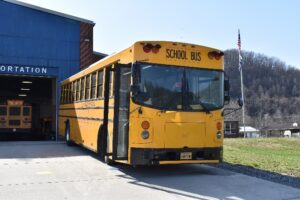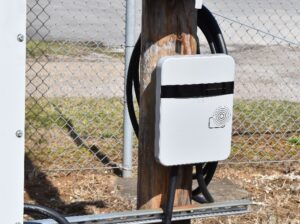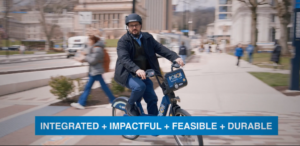S&B USA eMobility doesn’t just dream about the future. They are determined to make groundbreaking eMobility infrastructure a reality across the nation. The demand for electric cars has increased dramatically in recent years, with electric cars accounting for 5.6 percent of new car sales in 2022. As the newest offering from S&B USA, S&B USA eMobility leverages nearly 100 years of successful project delivery to help clients electrify now through Charging as a Service, Energy as a Service, and Fleet as a Service business models. These alternative delivery models sharply reduce the up-front capital costs for municipalities, government agencies, and private businesses, allowing a wide variety of clients to join the eMobility revolution.
 “From an environmental perspective, embracing eMobility is crucial for the well-being of future generations. By reducing carbon emissions, we take responsibility for creating a cleaner and more sustainable environment,” said Haggai Dror, Vice President of Business and Strategy and eMobility Lead for S&B USA. “Moreover, the transition to electric vehicles will lead to immediate improvements in our daily lives, such as reduced noise pollution and the elimination of exhaust fumes. Imagine children riding a super quiet school bus without exposure to harmful emissions. This significant improvement enhances our overall quality of life.”
“From an environmental perspective, embracing eMobility is crucial for the well-being of future generations. By reducing carbon emissions, we take responsibility for creating a cleaner and more sustainable environment,” said Haggai Dror, Vice President of Business and Strategy and eMobility Lead for S&B USA. “Moreover, the transition to electric vehicles will lead to immediate improvements in our daily lives, such as reduced noise pollution and the elimination of exhaust fumes. Imagine children riding a super quiet school bus without exposure to harmful emissions. This significant improvement enhances our overall quality of life.”
In the school bus industry, many providers are looking to make the jump to electric, but some are concerned about the cost of an electric vehicle (EV) overhaul. S&B USA eMobility recently found savings of 50 percent in energy and fueling costs, which for a school bus provider in Pennsylvania is equivalent to a lifetime of $40,400 in savings per bus. In addition to fuel savings, EVs require less maintenance than gas-powered vehicles, which can cut $50,000 per bus in lifetime maintenance costs. Long-term savings, as well as innovative financing, can make fleet electrification a feasible choice for many school bus providers.
As states like Ohio and New York rapidly grow their green infrastructure, S&B USA eMobility is determined to keep Pennsylvania up to speed with innovations in electric transportation technology. S&B USA eMobility is forward thinking, but their approach to electrification strives to be accessible and implementable. They have their eye on existing resources that can help Pennsylvania compete with big players in electrification.
“Ohio – our direct neighbor to the west – has received over $15 billion in investment directly and indirectly related to the manufacturing of EVs and EV components,” said Connor Hayes, EV Product Solutions Manager for S&B USA eMobility. “If Pennsylvanians want to stay on the forefront of transportation, we need to act now, and we need to act quickly.”
The National Electric Vehicle Initiative (NEVI) provides significant federal funding for the implementation of EV infrastructure. Pennsylvania has started to take advantage of the federal dollars, and to date, Pennsylvania has been allocated $170 million in NEVI program funds. S&B USA eMobility, in collaboration with their partner Francis Energy, recently submitted a highly competitive application for the first round of funding. The proposal aims to deploy fast charging stations with 4 or 8 plugs delivering 150 kW capacity along Pennsylvania’s major transportation corridors. This proactive approach underscores their commitment to developing robust charging infrastructure that will facilitate electric vehicle adoption and support long-distance travel throughout the state.
funds. S&B USA eMobility, in collaboration with their partner Francis Energy, recently submitted a highly competitive application for the first round of funding. The proposal aims to deploy fast charging stations with 4 or 8 plugs delivering 150 kW capacity along Pennsylvania’s major transportation corridors. This proactive approach underscores their commitment to developing robust charging infrastructure that will facilitate electric vehicle adoption and support long-distance travel throughout the state.
Range anxiety—the fear that the current charging infrastructure will not support an EV user’s needs—is a key concern for drivers making the switch to EV. Businesses looking to adopt EVs across their fleets share similar concerns, and they are looking for cost-effective, reliable, and easy-to-maintain solutions. As eMobility technologies continue to evolve, Pennsylvania has been proactively working to explore new solutions and address current challenges. The team at S&B USA eMobility is positioned to support Pennsylvania with investments in sustainable infrastructure supporting the future of transportation.
This build-first scenario could make Pennsylvania a leader in the sustainable transportation revolution. One forward-thinking approach proposed by S&B USA eMobility is the establishment of centralized and public fleet charging hubs, located and developed by public entities and accessible to investors interested in adding EV assets to their portfolio. By investing in infrastructure like charging hubs, Pennsylvania can continue to position itself as an attractive destination for businesses looking to capitalize on the benefits of EV as well as everyday EV users looking to drive with confidence.
 To contribute to widespread EV adoption, S&B USA eMobility is actively engaged in several projects that will benefit communities across Pennsylvania. At the University of Pittsburgh, S&B USA eMobility, in partnership with Nexxi, VHB, and Dagastino Electric Services, has been shortlisted as a finalist for the Pitt Sustainability Challenge. Their pitch “Panther Tracks: A Path to a Zero Emission Transportation” will facilitate the transition to electric alternatives for university transportation methods. To achieve this, they plan to use existing parking spaces on campus to implement efficient and effective electric vehicle charging infrastructure. This will enable commuters to drive to and from campus with confidence and decrease transportation emissions at the university.
To contribute to widespread EV adoption, S&B USA eMobility is actively engaged in several projects that will benefit communities across Pennsylvania. At the University of Pittsburgh, S&B USA eMobility, in partnership with Nexxi, VHB, and Dagastino Electric Services, has been shortlisted as a finalist for the Pitt Sustainability Challenge. Their pitch “Panther Tracks: A Path to a Zero Emission Transportation” will facilitate the transition to electric alternatives for university transportation methods. To achieve this, they plan to use existing parking spaces on campus to implement efficient and effective electric vehicle charging infrastructure. This will enable commuters to drive to and from campus with confidence and decrease transportation emissions at the university.
“While we are effectively addressing current challenges, it is equally important to look beyond the immediate horizon and adopt innovative approaches to eMobility,” said Dror. “By being daring and proactive in exploring uncharted territories, Pennsylvania can lead the way in creating a sustainable and thriving eMobility ecosystem.”
Innovation isn’t easy. The transition to a fully electric transportation system comes with up-front costs that S&B USA eMobility is excited to tackle head-on. Electrification is not only an economic choice, but a crucial one that protects our environment for future generations. By embracing innovative ideas and investing in eMobility infrastructure, Pennsylvania can set a visionary example for other states and attract investment from both public and private entities.